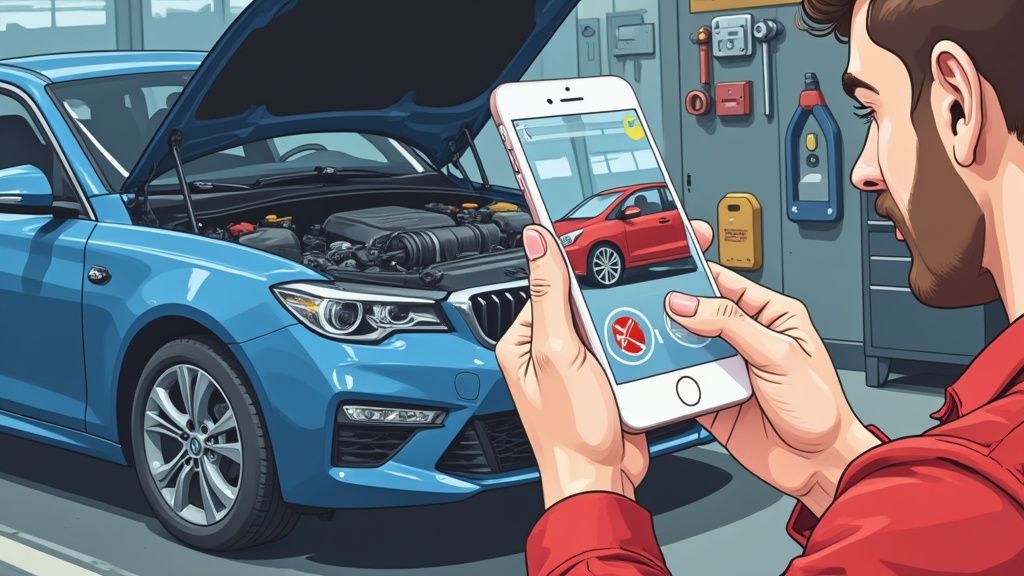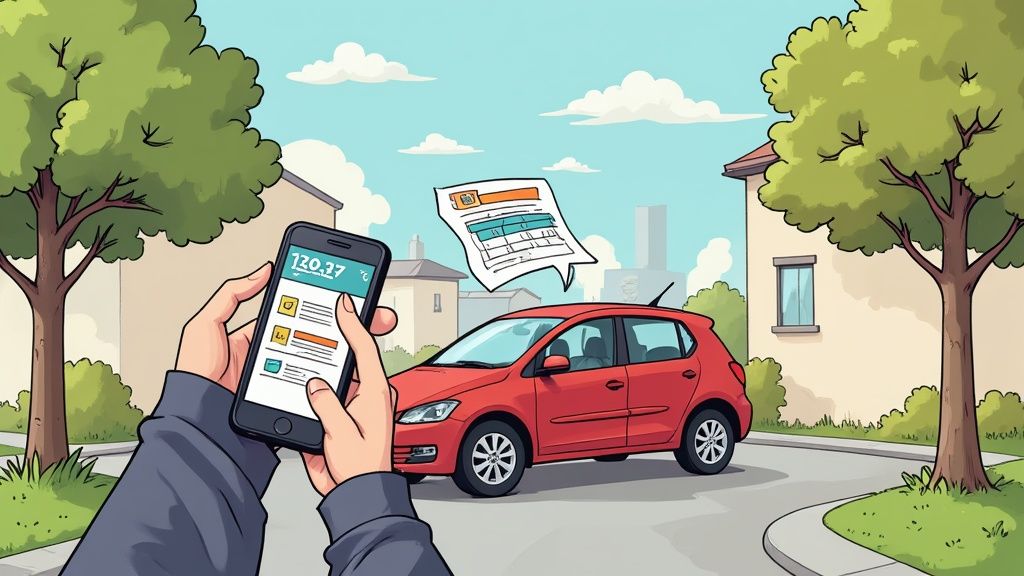
10 Best Apps for Car Service: Your Complete Guide to Smart Vehicle Care
The Digital Revolution in Vehicle Care

Car maintenance has entered a new era. Gone are the days of paper logbooks and blindly following mechanic recommendations. Today’s car service apps put vehicle owners in control, enabling proactive maintenance through the convenience of their smartphones. This shift mirrors broader changes in how we manage transportation - just look at the taxi app market, which reached $238.1 billion in 2023 and is expected to hit $468.4 billion by 2033.
Simplifying Maintenance with Apps
Car owners have long struggled with basic maintenance tasks like scheduling services, keeping records, and finding trustworthy mechanics at reasonable prices. Modern car service apps tackle these challenges head-on with easy-to-use interfaces. Instead of digging through old receipts and service records, drivers can now log and track everything digitally - from oil changes to fuel fill-ups. This detailed maintenance history becomes especially valuable when selling a vehicle since it provides clear proof of regular upkeep to potential buyers.
Key Features to Look For in Car Service Apps
When choosing a car service app, focus on the features that matter most for your needs. The best apps typically include:
- Service Reminders: Automatic alerts for scheduled maintenance like oil changes
- Digital Record Keeping: One secure place for all service records and warranties
- Repair Cost Estimates: Compare prices before visiting mechanics
- Mechanic Locators: Find and read reviews of local repair shops
- Fuel Efficiency Tracking: Monitor gas consumption and spot potential issues
Some advanced apps also offer real-time diagnostics and can predict when maintenance might be needed, helping prevent major repairs before they happen. This proactive approach often saves both time and money in the long run.
The Future of Car Care Is Digital
The growing popularity of vehicle-related apps points to permanent changes in how we maintain our cars. With over 1.69 billion people using ride-hailing apps in 2023 (projected to reach 2.31 billion by 2029), digital solutions are becoming the norm in the automotive world. As technology improves, these apps will connect even more closely with vehicles themselves, offering real-time data and personalized maintenance suggestions. This gives drivers better control over their car care, leads to smarter spending on maintenance, and makes vehicle ownership more manageable overall.
Must-Have Ride-Hailing Solutions

Ride-hailing apps have completely changed how we get around cities and access transportation services. What started as a simple way to request rides has evolved into sophisticated platforms that connect passengers with drivers at the tap of a button. Understanding these services helps you make smart choices about getting where you need to go.
Understanding the Ride-Hailing Landscape
The numbers tell an impressive story - the global ride-hailing market reached $238.1 billion in 2023. This growth comes from increasing demand for flexible transportation options, especially in regions like Asia Pacific which makes up over 34% of the market. High smartphone usage and growing urban populations have made these services essential, particularly in dense city centers where owning a car isn’t always practical.
Key Players and User Experiences
Looking at the major platforms, Uber and Lyft dominate the US market. As of March 2024, Uber holds 76% market share compared to Lyft’s 24%. Uber’s larger footprint is clear in its user base - 156 million active riders versus Lyft’s 23.7 million. But raw numbers don’t tell the whole story. Each service offers distinct benefits, from different pricing models to unique features that appeal to different types of riders.
Maximizing Benefits Across Multiple Apps
Smart users often install multiple ride-hailing apps to get the best deals and service. One app might offer better rates for quick trips across town, while another excels at airport runs. By comparing options, you can pick the right service for each situation. Having choices also helps during surge pricing or when rides are scarce in your area.
Hidden Features and Insider Tips
Beyond basic ride booking, these apps pack useful features many people don’t know about. You can schedule rides in advance, split fares with friends, or share your trip details with family for safety. Some services reward loyal customers with discounts and perks through membership programs. With ride-hailing expected to reach 2.31 billion users by 2029, knowing these extra features helps you get more value from the services. Take time to explore the settings and options in your favorite apps - you might discover helpful tools you didn’t know existed.
Smart Maintenance Tracking Tools

Car service apps have evolved far beyond simple ride booking features - they now offer powerful tools to help owners take better care of their vehicles. By enabling a shift from reactive repairs to proactive maintenance, these apps help drivers save time and money. This shift is especially relevant as more people depend on personal vehicles and ride-hailing services, with the taxi app market reaching $238.1 billion in 2023.
Predictive Analytics and Real-Time Monitoring
Modern car service apps use advanced analytics to monitor vehicle health in real-time. By tracking driving patterns, mileage, and vehicle data, these apps can spot potential issues before they become serious problems. For instance, you might receive an alert about brake wear based on your driving style, allowing you to address it early. The apps also provide insights into fuel efficiency and performance metrics, helping you maintain your vehicle at its best.
Building a Comprehensive Maintenance History
One major advantage of car service apps is their ability to create detailed maintenance records. Instead of searching for old receipts or trying to remember past service dates, you get a complete digital log of every repair and routine maintenance task. This documented history proves valuable when selling your vehicle since it demonstrates consistent care and maintenance. Think of it as your car’s health record - a clear timeline showing how well you’ve maintained it over the years.
Interpreting App Alerts and Making Informed Decisions
While maintenance apps provide extensive data, knowing how to use this information effectively is key. Not every notification means an immediate trip to the mechanic. Apps like Auto Service Logger help users understand alert meanings and prioritize maintenance needs. This guidance helps you make smart choices about repairs and avoid unnecessary expenses. Similar to managing personal health, understanding when to address minor issues versus seeking immediate attention is crucial for your vehicle.
Features That Contribute to Better Vehicle Performance
Car service apps include several tools that directly impact vehicle performance. The fuel efficiency tracker helps identify driving habits affecting gas mileage, while maintenance reminders ensure timely service to prevent larger issues. These features work together to give you a complete view of your car’s condition and help maintain peak performance. Regular monitoring through these apps is like getting routine health checkups - it helps catch problems early and keeps everything running smoothly. As more people adopt ride-hailing services, with user numbers expected to reach 2.31 billion by 2029, these maintenance tools become increasingly important for keeping vehicles reliable and efficient.
Seamless Payment Solutions

Car service apps continue to advance their payment capabilities to meet growing user needs. With the global taxi app market reaching $238.1 billion in 2023, modern payment systems have become essential. These integrated solutions make paying for vehicle services simpler and more convenient than traditional methods.
Simplified Transactions and Reduced Friction
One key advantage of car service apps is direct in-app payments, which eliminates the need to handle cash or physical cards. For example, when you complete a ride through a ride-hailing service, the payment processes automatically - no more searching for your wallet or calculating tips. This smooth payment flow is a major part of what makes these apps so practical and easy to use.
Enhanced Security and Fraud Prevention
Keeping financial transactions secure is a top priority. Car service apps use robust security features like tokenization to protect payment data, replacing sensitive information with secure tokens. Many also offer biometric authentication through fingerprint or facial recognition. These protective measures give users peace of mind while helping prevent fraud. The apps often include real-time monitoring so users can quickly spot any suspicious activity.
Multiple Payment Options and Reward Programs
Car service apps recognize that users have different payment preferences. They typically accept credit cards, debit cards, digital wallets like Apple Pay and Google Pay, and in-app balances. Many also feature rewards programs where users earn points or cashback on rides and services. The flexibility to switch between payment methods helps users maximize rewards and minimize fees.
Managing Expenses and Tracking Usage
Beyond basic payments, many car service apps include tools for expense management and usage tracking. This is especially helpful for people who use vehicles for both personal and business purposes. Apps like Auto Service Logger let users categorize expenses and create reports for taxes or reimbursements. These features make it simple to maintain accurate records and spot potential cost savings through better visibility into spending patterns. The comprehensive approach helps users effectively manage and monitor their vehicle-related expenses.
Global Trends and Market Innovation
Car service apps evolve differently across regions and countries, reflecting distinct local transportation needs and preferences. Just as ride-hailing adapted - with motorbike taxis dominating Southeast Asia while car-sharing leads in North America - car service apps must also align with regional dynamics. Success depends on understanding and responding to these local market differences.
Cultural Influences on App Adoption
Local culture shapes how people use and interact with car service apps. In societies where vehicle ownership signifies status, apps tend to focus on premium maintenance and luxury vehicle care. Meanwhile, areas with robust public transit see higher demand for features integrating with mass transportation and shared mobility options. Getting these cultural nuances right through solid market research is essential. Equally important are practical elements like supporting local languages and preferred payment methods to drive widespread adoption.
Regional Innovations in Car Service Apps
Different regions pioneer various car service app innovations based on their unique challenges. Dense urban centers in Asia have spawned apps that let users pre-book parking spots - a vital feature where space is scarce. Other markets favor apps connecting car owners with independent mechanics and mobile detailing services, showing how on-demand, personalized services emerge to meet specific local needs. This shows how regional demands drive different paths of innovation.
Adapting to Local Needs While Maintaining Global Standards
Building a successful global car service app requires carefully balancing local customization with consistent core functionality. Take Auto Service Logger as an example - its fundamental features like maintenance records and service reminders provide value everywhere. However, the app enhances its local relevance through market-specific additions like language options and integration with regional payment systems. Like major ride-hailing platforms that modify their pricing and vehicle types by region, car service apps must adapt while maintaining quality. This means actively gathering international user feedback and monitoring regional trends. For example, areas with advanced mobile networks may embrace telematics features, while other regions prefer simpler tools like fuel tracking. Understanding these differences is key to achieving both global reach and local success.
The Next Generation of Vehicle Care
Smart technology is making car maintenance easier and more intelligent than ever before. Modern car service apps do much more than help you find a mechanic or book an appointment - they use advanced technologies like Artificial Intelligence, sensors, and connected systems to give car owners a new level of control and insight into their vehicle’s health. This new approach to car care helps prevent problems before they happen and takes the guesswork out of maintenance.
AI-Powered Predictive Maintenance
One of the most valuable features of modern car service apps is predictive maintenance powered by AI. These apps collect and analyze data from your vehicle’s computer, driving patterns, and external conditions to spot potential issues early. For instance, the app might notice that based on your driving style and mileage, your brake pads will likely need replacement within 1,000 miles. This allows you to schedule service proactively, saving money and preventing breakdowns before they occur.
The Rise of the Connected Car
More vehicles now come equipped with internet connectivity, opening new possibilities for car service apps. Connected cars can send real-time information about their status directly to these apps, enabling personalized maintenance recommendations and automated service scheduling. For example, when your connected car detects that an oil change is needed based on actual oil life data, it can automatically book an appointment with your preferred service center. This removes the burden of tracking maintenance intervals manually.
IoT and the Future of Vehicle Diagnostics
The Internet of Things has made vehicle health monitoring much more precise. By connecting sensors throughout your car, service apps can track engine performance, tire pressure, and other vital systems in real-time. This constant stream of data helps catch small problems before they become major repairs. Many apps can even share this diagnostic information directly with mechanics, who can troubleshoot issues remotely and let you know if an in-person visit is truly needed.
Choosing the Right Apps for Car Service
With many car service apps available, focus on finding one that matches your needs. Look for key features like AI-based maintenance predictions, compatibility with your vehicle’s systems, and easy integration with local service providers. The best apps have clear, simple interfaces and strong data security. They should make maintaining your car easier, not more complicated. Good customer support is also essential for getting help when you need it.
Ready to experience the future of car care? Start logging and tracking your vehicle maintenance effortlessly with Auto Service Logger. Get lifetime access to personalized reports, dedicated support, and all future updates for a one-time fee. Visit https://autoservicelogger.com/ today and take control of your vehicle’s health.